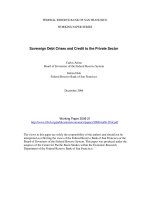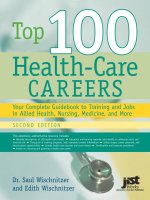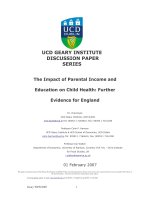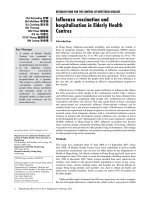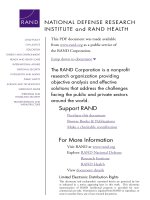Pharmacy Use and Costs in Employer-Provided Health Plans - Insights for TRICARE Benefit Design from the Private Sector pptx
Bạn đang xem bản rút gọn của tài liệu. Xem và tải ngay bản đầy đủ của tài liệu tại đây (794.24 KB, 105 trang )
This PDF document was made available
from www.rand.org as a public service of
the RAND Corporation.
6
Jump down to document
Visit RAND at www.rand.org
Explore RAND National Defense
Research Institute
RAND Health
View document details
This document and trademark(s) contained herein are protected by law
as indicated in a notice appearing later in this work. This electronic
representation of RAND intellectual property is provided for non-
commercial use only. Permission is required from RAND to reproduce, or
reuse in another form, any of our research documents.
Limited Electronic Distribution Rights
For More Information
CHILD POLICY
CIVIL JUSTICE
EDUCATION
ENERGY AND ENVIRONMENT
HEALTH AND HEALTH CARE
INTERNATIONAL AFFAIRS
NATIONAL SECURITY
POPULATION AND AGING
PUBLIC SAFETY
SCIENCE AND TECHNOLOGY
SUBSTANCE ABUSE
TERRORISM AND
HOMELAND SECURITY
TRANSPORTATION AND
INFRASTRUCTURE
The RAND Corporation is a nonprofit
research organization providing
objective analysis and effective
solutions that address the challenges
facing the public and private sectors
around the world.
NATIONAL DEFENSE RESEARCH
INSTITUTE and RAND HEALTH
Purchase this document
Browse Books & Publications
Make a charitable contribution
Support RAND
This product is part of the RAND Corporation monograph series.
RAND monographs present major research findings that address the
challenges facing the public and private sectors. All RAND mono-
graphs undergo rigorous peer review to ensure high standards for
research quality and objectivity.
Pharmacy Use and Costs
in Employer-Provided
Health Plans
Insights for TRICARE Benefit Design
from the Private Sector
Geoffrey Joyce
Jesse D. Malkin
Jennifer Pace
Approved for public release; distribution unlimited
Prepared for the Office of the Secretary of Defense
The RAND Corporation is a nonprofit research organization providing
objective analysis and effective solutions that address the challenges
facing the public and private sectors around the world. RAND’s
publications do not necessarily reflect the opinions of its research clients
and sponsors.
R
®
is a registered trademark.
© Copyright 2005 RAND Corporation
All rights reserved. No part of this book may be reproduced in any
form by any electronic or mechanical means (including photocopying,
recording, or information storage and retrieval) without permission in
writing from RAND.
Published 2005 by the RAND Corporation
1776 Main Street, P.O. Box 2138, Santa Monica, CA 90407-2138
1200 South Hayes Street, Arlington, VA 22202-5050
201 North Craig Street, Suite 202, Pittsburgh, PA 15213-1516
RAND URL: />To order RAND documents or to obtain additional information, contact
Distribution Services: Telephone: (310) 451-7002;
Fax: (310) 451-6915; Email:
Library of Congress Cataloging-in-Publication Data
Joyce, Geoffrey.
Pharmacy use and costs in employer-provided health plans : insights for TRICARE
benefit design from the private sector / Geoffrey Joyce, Jesse D. Malkin, Jennifer Pace.
p. cm.
Includes bibliographical references.
“MG-154.”
ISBN 0-8330-3549-5 (pbk. : alk. paper)
1. Pharmacy, Military—United States. 2. Insurance, Pharmaceutical services—
United States. 3. United States—Armed Forces—Medical care. 4. Veterans—Medical
care—United States—Periodicals. 5. Retired military personnel—Medical care—
United States. 6. Military dependents—Medical care—United States. 7. Drugs—
Prices—United States. I. Malkin, Jesse D., 1969- II. Pace, Jennifer. III. Title.
UH423.J68 2004
368.38'24—dc22
2004001289
The research described in this report was sponsored by the Office of
the Secretary of Defense (OSD). The research was conducted jointly
by the Center for Military Health Policy Research, a RAND Health
program, and the Forces and Resources Policy Center, a RAND National
Defense Research Institute (NDRI) program. NDRI is a federally funded
research and development center supported by the OSD, the Joint
Staff, the unified commands, and the defense agencies under Contract
DASW01-C-01-0004.
iii
Preface
Section 701 of the National Defense Authorization Act for Fiscal Year
2000 requires the Secretary of Defense to establish an effective, effi-
cient, and integrated pharmacy benefits program. As part of a pro-
gram redesign effort, which will result in the establishment of a Uni-
form Formulary, the Department of Defense (DoD) is considering
moving from a two-tiered copayment system to a three-tiered copay-
ment system. To assist the DoD in assessing the potential implica-
tions of this policy change, the RAND Corporation used an existing
data resource from the civilian sector to examine how beneficiaries
with private drug coverage responded to similar changes in pharmacy
benefits. The findings from this analysis can inform the DoD of the
potential costs and benefits of adopting the proposed Uniform For-
mulary (UF).
This report covers research that was conducted from March
through July 2003 on one of two phases of a research project on the
proposed UF. A second report, scheduled for publication in 2004,
will describe TRICARE Senior Pharmacy utilization during Fiscal
Year 2002 and will examine determinants of the dispensing location,
which influences pharmacy costs. The study findings reported here
should be of interest to TRICARE Management Activity personnel
and others with an interest in pharmacy benefit design.
This work was sponsored by the Assistant Secretary of Defense
for Health Affairs. The project was carried out jointly by RAND
Health’s Center for Military Health Policy Research and the Forces
and Resources Policy Center of the National Defense Research Insti-
iv Pharmacy Use and Costs in Employer-Provided Health Plans
tute. The latter is a federally funded research and development center
sponsored by the Office of the Secretary of Defense, the Joint Staff,
the unified commands and the defense agencies.
Questions regarding this report should be directed to the princi-
pal investigators, Geoffrey Joyce () and Jesse Malkin
(). Susan Everingham () is the di-
rector of RAND’s Forces and Resources Policy Center and C. Ross
Anthony () is director of the RAND Center for Mili-
tary Health Policy Research.
v
The RAND Corporation Quality Assurance Process
Peer review is an integral part of all RAND research projects. Prior to
publication, this document, as with all documents in the RAND
monograph series, was subject to a quality assurance process to ensure
that the research meets several standards, including the following:
The problem is well formulated; the research approach is well de-
signed and well executed; the data and assumptions are sound; the
findings are useful and advance knowledge; the implications and rec-
ommendations follow logically from the findings and are explained
thoroughly; the documentation is accurate, understandable, cogent,
and temperate in tone; the research demonstrates understanding of
related previous studies; and the research is relevant, objective, inde-
pendent, and balanced. Peer review is conducted by research profes-
sionals who were not members of the project team.
RAND routinely reviews and refines its quality assurance pro-
cess and also conducts periodic external and internal reviews of the
quality of its body of work. For additional details regarding the
RAND quality assurance process, visit />standards/.
vii
Contents
Preface iii
Figures
ix
Tables
xi
Summary
xiii
Acknowledgments
xxi
Acronyms
xxiii
CHAPTER ONE
Introduction 1
CHAPTER TWO
Background 3
The TRICARE Senior Pharmacy Program
4
The DoD Formulary System
6
Prices Paid by DoD for Outpatient Pharmacy Items
8
Pharmacy Costs and Use in the Private Sector
9
Summary
10
CHAPTER THREE
Data Sources and Methods 13
Data Sources
13
Study Sample
14
Data Cleaning
16
Dependent and Explanatory Variables
16
Dependent Variables
16
Explanatory Variables
17
viii Pharmacy Use and Costs in Employer-Provided Health Plans
Statistical Techniques 19
Model Specifications
21
Class-Level Analyses
22
Drug-Level Analyses
23
CHAPTER FOUR
Analysis Results 25
Descriptive Statistics
25
How Does Civilian Population Pharmacy Use Compare with Use by
TRICARE Non–Active-Duty Beneficiaries?
26
How Do Pharmacy Costs and Use Differ by Type of Drug Benefit? 28
Multivariate Analyses
31
Aggregate Analyses
31
Class-Level Analyses
35
Drug-Level Analyses
36
Summary
38
CHAPTER FIVE
Conclusions and Policy Implications 41
Generalizability
41
Study Limitations
44
Policy Implications
46
Summary
48
APPENDICES
A. Relationship Between Pharmacy Costs and Age 51
B. Results of Multivariate Regressions: Aggregate Analyses
55
C. Results of Multivariate Regressions: Classs-Level Analyses
69
Bibliography
77
ix
Figures
3.1. Distribution of Pharmacy Benefits in 20 Employer-Provided
Health Plans, 1999–2000
16
4.1. Predicted Change in Total Pharmacy Spending by Therapeutic
Class, 2000
36
4.2. Effect of Moving Prilosec (Omeprazole) from Second to Third
Tier
37
4.3. Effect of Moving Zocor (Simvastatin) from Second to Third
Tier
38
4.4. Effect of Moving Allegra (Fexofenadine) from Second to Third
Tier
39
A.1. Medical Care Spending by Age and Health Status
52
A.2. Pharmacy Spending by Age and Health Status
53
xi
Tables
2.1. Growth in Pharmacy Spending 4
2.2. Current Copay Structure
5
2.3. Proposed Copayment Structure
8
3.1. Dependent Variables Used in the Analysis
17
3.2. Chronic Conditions Used as Independent Variables in the
Analysis
18
3.3. Covariates Included in Multivariate Models of Pharmacy Costs
and Use
19
3.4. Framework of Difference-in-Differences Methodology
19
3.5. Model Specifications
22
4.1. Mean Copayments by Plan Type, 1999 and 2000
26
4.2. Pharmacy Use Among 45- to 64-Year-Olds in TRICARE and
Private-Sector Plans
27
4.3. Average Pharmacy Spending and Use per Member, per Year,
1999
28
4.4. Average Pharmacy Costs and Use by Plan Type and Year,
1999–2000
30
4.5. Change in Pharmacy Costs for Selected Therapeutic Classes,
1999–2000
32
4.6. Predicted Increase in Pharmacy Spending by Plan Type,
1999–2000
33
A.1. Average Outpatient Prescription Drug Use and Costs,
by Age
51
B.1. Regression Results of Change in Total Pharmacy Spending
56
xii Pharmacy Use and Costs in Employer-Provided Health Plans
B.2. Weighted Regression Results of Change in Total Pharmacy
Spending
57
B.3. Regression Results of Change in Plan Spending
58
B.4. Weighted Regression Results of Change in Plan Spending
59
B.5. Regression Results of Change in Beneficiary Spending
60
B.6. Weighted Regression Results of Change in Beneficiary
Spending
61
B.7. Probit Regression Results of Change in Probability of Pharmacy
Use
62
B.8. Weighted Probit Regression Results of Change in Probability
of Pharmacy Use
63
B.9. Negative Binomial Regression Results of Change in Number
of 30-Day Prescriptions
64
B.10. Weighted Negative Binomial Regression Results of Change in
Number of 30-Day Prescriptions
65
B.11. Regression Results of Change in Total Mail-Order Pharmacy
Spending
66
B.12. Weighted Regression Results of Change in Total Mail-Order
Pharmacy Spending
67
C.1. Regression Results of Change in Spending on
Antidepressants
70
C.2. Regression Results of Change in Spending on
Antihypertensives
71
C.3. Regression Results of Change in Spending on Non-Steroidal
Anti-Inflammatory Drugs
72
C.4. Regression Results of Change in Spending on
Antihistamines
73
C.5. Regression Results of Change in Spending on Gastrointestinal
Drugs
74
C.6. Regression Results of Change in Spending on Antidiabetic
Drugs
75
xiii
Summary
Background
The military health system (MHS) has approximately 8.6 million eli-
gible beneficiaries, including active-duty military personnel and their
family members, retired military personnel and their family members,
and surviving family members of deceased military personnel. In
2002, the Department of Defense (DoD) spent about $3 billion on
outpatient pharmacy benefits. Like the private health care sector, the
MHS has experienced a rapid growth in pharmaceutical expenditures.
At the request of DoD, the RAND Corporation has undertaken two
studies designed to help DoD shape their pharmacy benefit policy to
control costs.
The U.S. Congress has identified the TRICARE pharmacy
benefit as an area for reform. Section 701 of the National Defense
Authorization Act for Fiscal Year 2000 requires the Secretary of De-
fense to establish an effective, efficient, and integrated pharmacy
benefits program. As part of a program redesign effort, which will
result in the establishment of a Uniform Formulary (UF), the DoD is
considering moving from a two-tiered copayment system to a three-
tiered copayment system, which will increase the copayment for some
classes and brands of medications. It is hoped that this move will give
providers (acting in the interest of their patients) an incentive to pre-
scribe lower-tier, less-costly options. To assist the DoD in assessing
the potential implications of this policy change, RAND used an ex-
isting data resource to examine how beneficiaries with private drug
xiv Pharmacy Use and Costs in Employer-Provided Health Plans
coverage responded to similar changes in pharmacy benefits. The
findings from this analysis, presented in this report, can inform the
DoD of the potential costs and benefits of adopting the proposed
Uniform Formulary.
Approach
To predict the effects on cost and utilization of changing the current
two-tiered DoD formulary to a three-tiered one, we performed a
quantitative analysis of pharmacy claims from a group of private-
sector health plans that instituted a similar change in coverage. The
purpose of this analysis was to assess the effect of the change in cover-
age on aggregate costs and utilization of several specific (high-cost)
classes of medications and the changes in market share within those
classes.
We assembled a unique data set linking health care claims to
health plan benefits of 25 Fortune 500 employers for 1999 and 2000.
The data were made available under license from Ingenix Inc., a unit
of UnitedHealth Group that provides cost-management and benefit
consulting services to employers, health plans, pharmaceutical manu-
facturers, and other groups. The data for these analyses included de-
tailed information on insurance eligibility as well as information on
medical and pharmacy claims for employees and retirees and their
dependents.
The study sample consisted of 56,840 primary beneficiaries who
were continuously enrolled in an employer-provided plan with drug
coverage for two years. Because the Ingenix data do not support
analysis of seniors age 65 and over, we focused on the behavioral re-
sponses of a pre-Medicare population age 45 to 64.
We compared the change in pharmacy costs and use in seven
plans that added a third tier during our period of analysis with those
in 13 plans that did not change drug benefits during the two-year pe-
riod (six plans that remained two-tier and seven that had become
three-tier plans before the start of our analysis period). We included
only two- and three-tier plans because they correspond to the current
Summary xv
TRICARE drug benefit structure and the proposed copayment struc-
ture under the Uniform Formulary, respectively.
Our analysis assessed the effects of the benefit design (two-tier
versus three-tier) and a number of beneficiary characteristics (such as
demographics, illnesses, and type of health coverage) on three meas-
ures of the cost of providing pharmacy benefits: total yearly costs per
beneficiary (costs to the payer plus costs to the beneficiary), total
yearly payer costs per beneficiary, and total yearly enrollee costs per
beneficiary.
To examine whether benefit design affects pharmacy costs and
pharmacy use differentially across therapeutic drug classes, we per-
formed analyses focusing on each of six high-cost therapeutic classes
that together account for more than one-fourth of total drug expendi-
tures: antidepressants, antihypertensives, non-steroidal anti-
inflammatory drugs (NSAIDs), oral antihistamines, gastrointestinal
agents, and oral hypoglycemics. Finally, we also assessed how copay-
ment tiers affect demand for a particular drug by plotting changes in
market shares (of 30-day-equivalent prescriptions and of total phar-
macy expenditures) when a specific medication was moved from the
second to the third tier.
Results
Our research results can be summarized as follows:
• Total pharmacy expenditures, defined as plan expenditures plus
beneficiary out-of-pocket expenditures, rose more than twice as
fast in two-tier plans that did not add a third-tier than in two-
tier plans that did add a third tier, although the difference was
not statistically significant.
• Plan expenditures rose significantly faster in fixed two-tier plans
than in new three-tier plans. The rate of growth in plan expendi-
tures was 19–21 percent in the fixed two-tier plans, compared
with 4–6 percent in the new three-tier plans.
xvi Pharmacy Use and Costs in Employer-Provided Health Plans
• Beneficiary expenditures grew more rapidly in three-tier plans,
both new and fixed, than in fixed two-tier plans. Copayment
outlays by enrollees increased $7 per member per year during
the first year in fixed two-tier plans, $27 per member per year in
fixed three-tier plans, and $38 per member per year in new
three-tier plans, although the differences were not statistically
significant.
• Both total pharmacy expenditures and plan expenditures rose
faster in fixed two-tier plans than in fixed three-tier plans, al-
though the difference was seldom statistically significant.
• Adding a third tier was not associated with a significant change
in the number of 30-day-equivalent prescriptions that are dis-
pensed or the probability of any pharmacy use.
• The pattern observed in the aggregate analyses was observed for
most high-cost therapeutic classes, but not for oral hypoglyce-
mics and gastrointestinal drugs. The finding of no relationship
between plan type and oral hypoglycemic expenditures is ex-
plained by the fact that none of the plans in our sample placed
oral hypoglycemics in the third tier. We could not explain the
finding related to gastrointestinal drugs.
• The introduction of a third tier had an even stronger effect on
spending at mail-order pharmacies.
• Drug-level analyses showed no consistent relationship between
changes in tier status and changes in market share. However, for
specific medications in some plans, the fall in market share was
precipitous after the drug was moved to the third tier.
Conclusions, Limitations, and Policy Implications
If the DoD’s experience in adopting the Uniform Formulary resem-
bles that of the private-sector civilian plans we analyzed, the cost
savings will be substantial. A 15-percentage-point reduction in the
rate of growth in DoD spending, for example, would generate savings
of nearly $200 million in the TRICARE Senior Pharmacy (TSRx)
program in the first year. However, many factors affect the applica-
Summary xvii
bility of these results to the TRICARE program; these factors should
be carefully considered as the new benefit program is implemented:
• Many pharmacy benefit features other than the number of tiers
and copayment levels (some of which are already incorporated
into the TRICARE pharmacy benefit) affect pharmacy costs and
use, but these factors could not be identified in the Ingenix data
set.
• As a federal buyer, the DoD is generally able to negotiate better
prices on pharmaceutical products than civilian firms, who are
constrained by Medicaid best-price regulations.
• The Ingenix database does not provide information about
manufacturer rebates; thus, our findings may underestimate cost
savings; we assume manufacturers would be willing to grant
such price concessions to the DoD.
• The proposed UF differs in a key respect from the reforms
adopted by the civilian plans in that the UF would make non-
preferred (third-tier) brands available through the TRICARE
Mail Order Pharmacy (TMOP)
1
plan for a copayment of $22
for a 90-day supply, which would limit the utilization-
dampening effect of adding a third tier, all other things re-
maining equal. However, DoD expenditures may decline if
utilization shifts from costlier civilian pharmacies to the TMOP.
• For the DoD to achieve the cost savings realized by the civilian-
sector employers we studied, the DoD will need to be as aggres-
sive as the average employer in placing drugs in high-cost thera-
peutic classes in the third tier.
The limitations of this study include the following:
• Although our focus is on the TSRx program, our sample was
limited to 45- to 64-year-olds because the Ingenix data set did
not support analysis of elderly beneficiaries (age 65 and older).
_____________
1
On March 1, 2003, the Department of Defense National Mail Order Pharmacy (NMOP)
program changed to the TRICARE Mail Order Pharmacy (TMOP) program.
xviii Pharmacy Use and Costs in Employer-Provided Health Plans
The elderly and pre-elderly appear to have similar demands for
prescription drugs; however, they differ in other ways that might
affect the applicability of our findings.
• The study was limited to a modest number of plans (20), al-
though the number of beneficiaries was large.
• The finding of higher pharmacy spending in plans that had
three tiers at the start of the study suggests that some employers
may tailor benefits to employee demands.
This study has a number of policy implications for the DoD as
well as others who are concerned with pharmacy benefit design:
• To achieve savings without adverse health consequences, the
drugs in a particular class should be easily substitutable and thus
distinguishable principally on the basis of price.
• The level of administrative restrictions and other financial incen-
tives, such as those that encourage use of TMOP, will also im-
pact the magnitude of savings.
• The transition to the new program raises another important is-
sue. The principal concern here regards the potential for adverse
health effects when patients switch from an effective medication
to a medication they have not used in the past. To achieve the
significant cost savings suggested in this study without adversely
impacting health, the DoD Pharmacy & Therapeutics Commit-
tee should carefully consider the drugs and drug classes that it
places in the nonpreferred third tier. The most heavily scruti-
nized drugs should be those in the costliest therapeutic classes,
which account for a disproportionate share of expenditures.
• Recent growth in pharmacy spending has been largely due to the
increased number of prescription drugs dispensed rather than
rising drug prices. If this trend continues, changes in benefit
structures are likely to play a larger role in reducing the level of
drug spending than in slowing the growth in expenditures.
• TRICARE Management Activity (TMA) policymakers must
also consider the critical question of whether lower pharmaceu-
tical use resulting from higher patient cost-sharing adversely af-
Summary xix
fects clinical outcomes and overall medical spending. Several
previous studies support concerns about adverse effects. Other
studies, by contrast, suggest that the effects of prescription drug
cost containment policies are mostly benign. Our study found
that adding a third tier did not reduce the probability of phar-
macy use, but further study is needed to determine if substitu-
tion from nonpreferred to preferred products resulted in adverse
health outcomes.
At the time of this writing, Congress is considering enacting
legislation to add a prescription drug benefit to the Medicare pro-
gram. Our findings regarding the effect of multi-tier cost sharing on
costs and utilization have implications not only for the TRICARE
benefit but also for the Medicare drug benefit.
xxi
Acknowledgments
We are extremely grateful for the valuable support that we received
throughout this project from our Project Officer at the TRICARE
Management Activity, Commander Thomas Mihara. We are also in-
debted to COL William Davies, DoD Pharmacy Program Director,
and the staff of the Pharmaco-Economic Committee, who patiently
responded to a number of questions during the course of the project.
We also appreciate the time and energy that several TMA contractors
devoted to the project: Wendy Funk of Kennell and Associates Inc.
and Chaya Merrill and Bill Pierce of STI Consulting Inc. We want to
thank Ross Anthony and Terri Tanielian of the RAND Center for
Military Health Policy Research and Susan Everingham, director of
the RAND Forces and Resources Policy Center, for their support and
feedback, both in helping to secure funding for this work and also in
ensuring its completion. We thank Ken Theriault and Jill Rubenstein
at Ingenix, Inc. for data support. Finally, we have benefited greatly
from the thoughtful comments provided by several RAND col-
leagues—Thomas Croghan, Sydne Newberry, Jeffrey Wasserman,
Peter Glassman, and Dana Goldman—who reviewed earlier versions
of this report.
xxiii
Acronyms
ACE angiotensin converting enzyme
AWP average wholesale price
BCF basic core formulary
CMS Centers for Medicare & Medicaid Services
CY Calendar year
DoD Department of Defense
DSCP Defense Supply Center Philadelphia
FDA U.S. Food and Drug Administration
FY fiscal year
GI gastrointestinal
HMG CoA 3-hydroxy-3 methylglutaryl co-enzyme A
ICD-9-CM International Classification of Diseases, Ninth
Revision, Clinical Modification
MHS Military Health System
MTF military treatment facility
NDAA National Defense Authorization Act
NSAID non-steroidal anti-inflammatory drug
OLS ordinary least squares
p-value probability value
P&T Pharmacy & Therapeutics (Committee)




